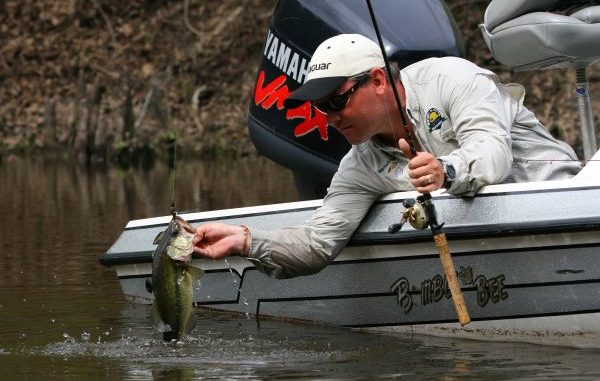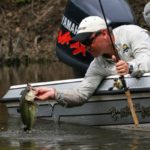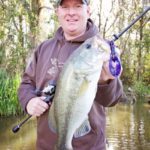
Today’s bass fishermen can choose from myriad lures and tactics, but that availability can often complicate the job of putting fish in the boat. Simplifying can keep you on track.
As a photographer, I learned a long time ago that it is simple to make images look complicated.
The opposite is also true — it is complicated to make images look simple.
Without going into a long, drawn-out photography lesson, I’ll just drop this little tidbit on you: Don’t try to include everything in a single image.
The only way you can accomplish this is to learn how to cut the clutter, because clutter distracts the eye. And when your eye is distracted, you really can’t tell what the photographer wanted you to see.
In the eyes of some, bass fishing has become a picture of clutter, and nowhere is that clutter more evident than in our bass boats.
Does that 10-inch fish finder distract your eye?
Are you tripping over 15 rods spread across the deck?
Do you spend more time tying on your 20 different colors of crankbaits than you do dragging them through the water?
According to two bass anglers from opposite ends of the state, the only way to see more bass is to start cutting some of that clutter.
“I’m just as guilty as the next guy,” said Covington-based tournament angler Jason Pittman, “but I made a conscious effort earlier this year to start simplifying the way I fish and get back to the basics.”
Pittman’s back-to-basics conversion came while he and his dad were fishing Toledo Bend. They were trying all kinds of techniques when his father recalled how he used to catch fish on this particular spot so long ago.
“Black lizard with a blue tail,” Pittman recalled his dad saying. “Danged if it didn’t work.”
West Monroe angler Kenny Covington’s back-to-basics conversion happened when he really started studying his compilation of 25 years worth of fishing notes.
“The first thing that stood out to me was that when I caught fish on a buzzbait, it was always either white or black,” he noted. “And although I had records of catching fish on a few different jig colors, most of my jig fish over the years came on black-and-blue or Texas craw.”
After their revelations, both anglers started simplifying their bass fishing by eliminating some of the clutter that was keeping them from keeping their eyes totally focused on catching fish.
They also both agreed that there is no better time to learn how to keep it simple than during September.
“For me, September has always been the hardest month to fish because the fish are in limbo,” Covington said. “They’re not really in a fall pattern yet, but they’re not really still in their summer patterns.”
Rather than make a difficult situation even worse, Covington and Pittman cut the clutter that could cause them to go home empty-handed and make it less confusing by first simplifying where they fish and then by simplifying how they fish.
Interestingly enough, each angler insisted the first simplification they would make during September would be to fish rivers rather than lakes.
Pittman proved that last year after we launched his small river boat at Crawford’s Landing in Slidell.
“Here on the West Pearl (River), especially, you know you’re going to have some current,” he said. “Fish aren’t going to suspend out in the middle of the river in current, so fishing a river is simple because you know where you’ve got to fish.”
On the Pearl down south and the Ouachita River up north, all anglers really have to do is find a bank with a bunch of stuff on it to block the current and pick up some kind of jig, worm, crawfish or crankbait and get to fishing.
Pittman has had a lot of success pitching jigs and soft plastics to obvious pieces of cover in the lower part of the West Pearl below Indian Village. It’s just a matter of pitching to the upcurrent and downcurrent sides of the cover until he figures out if bass are holding upstream or down.
“In either case, bass are going to hold around anything that breaks the current,” Pittman explained. “With so much stuff blocking the current on these banks, it isn’t very complicated to figure out what you’ve got to fish.”
Up north, Covington can look back in his fishing log and see that time after time he has smoked the bass on a splatterback-colored medium-diving crankbait.
“Fishing the Ouachita River this time of year definitely simplifies everything,” he said. “That’s because everything that holds a fish is obvious, and you don’t have to idle around forever trying to find some deep hole with your electronics; just pick a bank that looks good and go.”
Although rivers might offer the simplest fishing during September, Pittman and Covington know there is also a way to simplify fishing a large reservoir.
In Pittman’s case, he simplifies fishing Toledo Bend during September by following the shad.
“September is the month when shad transition to the backs of the creeks,” he explained. “This is one of those deals when you know the shad are going to be somewhere between the main points of a cove or a creek and the backs.”
Once the bass move in with the shad, Pittman said the bank beaters come out.
“And I’m one of them,” he laughed. “Whether you’re throwing a spinnerbait or some kind of vibrating bait like a LiveTarget Lipless Rattlebait, all you’ve got to do is drop your trolling motor at the point and fish down one bank and come back up the other.”
For Covington, finding simple fishing during September means heading to Lake D’Arbonne in Farmerville if he isn’t fishing the Ouachita River.
According to him, a lot of people don’t realize that a second shad spawn leads to a lot of small shad swimming around on the flats just off the main creek channels.
“You want simple?” he said. “Tie on a chrome-and-blue ¼-ounce (Rat-L-)Trap and throw it on the flats. While the bass are hanging out to see what the weather is going to do during September, you’re a lot better off picking out something that matches what the bass are eating and keeping it in the water where they’re eating.”
And if you are a tournament angler, Pittman said you can simplify your fishing by tuning out what he called dock talk.
“Just about everybody is guilty of dock talk,” he said. “And if you listen to some guy talking about how he caught them on a Carolina-rigged centipede in 20 feet of water and go out there and try it, even though you’ve never caught fish like that before, all you’re doing is cluttering up your mind.”
Admittedly, there is nothing wrong with trying new presentations, but doing it because you heard some hotshot talking about it back at the dock will keep you from staying focused on how you know you can catch fish.
“And knowing how you can catch fish is all about confidence,” Covington added. “If you are confident in a pattern, let the fish tell you when to change — not some guy back at the dock.”
He also said many anglers simply packed too much tackle into their boats.
“ I think the best thing people can do to keep their fishing simple is to get the clutter out of their tackle boxes,” Covington said. “That means stocking it full of your confidence baits in your confidence colors.”
For a creature whose tiny brain drives it to eat and reproduce, we sure spend a lot of time trying to outsmart bass.
Yes, studies have shown that bass learn from positive and negative experiences, but having much larger brains, so can we.
In other words, if you’re having a bad day on the water, remember what didn’t work. If you’re having one of those kinds of days when you can’t do anything wrong and bass seem to be jumping in your boat, remember what worked.
Simplify your fishing by getting rid of the stuff that doesn’t work. Sure, there’s probably a time and place where one of those baits, rods or techniques you’re about to toss out might catch some fish, but all they’re going to do most of the time is clutter up your fishing.
It’s easy to hit the water with 15 poles rigged with 15 baits in 15 different colors, but if you want to keep your eye on the big picture you’re going to have to simplify your fishing by cutting the clutter.
It’s as simple as that.




